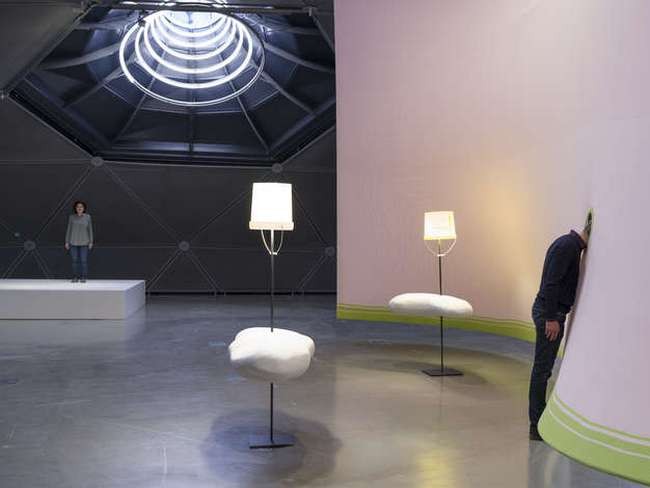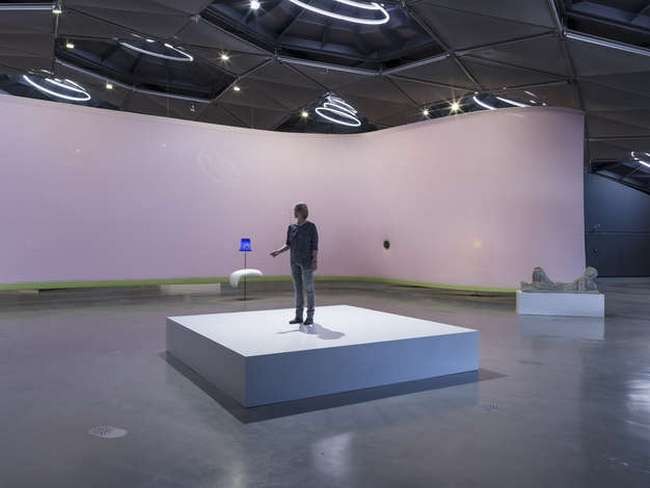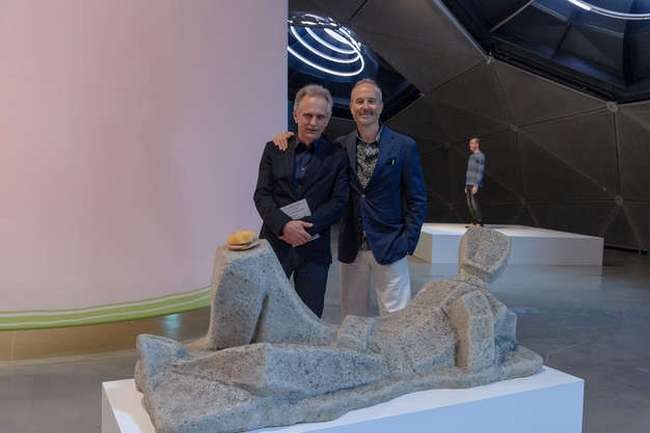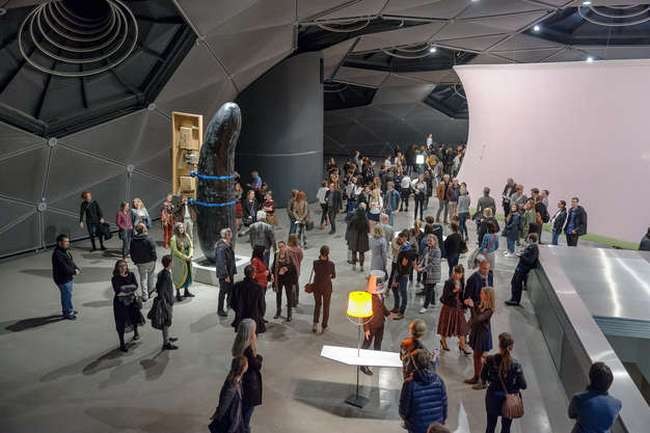Erwin Wurm
Football-sized Lump Of Clay On Light Blue Car Roof
24 Mar - 20 Aug 2017

Construction of the exhibition, "Erwin Wurm", Kunsthaus Graz, 2017
Photo: N.Lackner, UMJ © Bildrecht, Wien 2017
Photo: N.Lackner, UMJ © Bildrecht, Wien 2017

Installationsansicht, „Erwin Wurm“, Kunsthaus Graz, 2017, Foto: Universalmuseum Joanneum/N. Lackner, © Bildrecht, Wien 2017

Installationsansicht, „Erwin Wurm“, Kunsthaus Graz, 2017, Foto: Universalmuseum Joanneum/N. Lackner, © Bildrecht, Wien 2017

Installationsansicht, „Erwin Wurm“, Kunsthaus Graz, 2017, Foto: Universalmuseum Joanneum/N. Lackner, © Bildrecht, Wien 2017

Installationsansicht, „Erwin Wurm“, Kunsthaus Graz, 2017, Foto: Universalmuseum Joanneum/N. Lackner, © Bildrecht, Wien 2017

Erwin Wurm, Ohne Titel, 2016, (unter Verwendung von: Fritz Wotruba, Liegende Figur, 1953),
Photo: N.Lackner, UMJ © Bildrecht, Wien 2017
Photo: N.Lackner, UMJ © Bildrecht, Wien 2017
ERWIN WURM
Football-sized Lump Of Clay On Light Blue Car Roof
24 March - 20 August 2017
Curated by: Günther Holler-Schuster
About the Exhibition
The exhibition by Erwin Wurm (*1954 in Bruck an der Mur) in the Kunsthaus Graz takes as its starting point the open architectural structure of the Kunsthaus. Elements of the performative, participatory and sculptural form are thus connected to one another and to the building. In Wurm’s work essential lines of development in the sculpture of the 20th and 21st century emerge – from the object, to the action, to the creating of the image. Presence and absence move through Wurm’s work as issues, whereby absences in particular (whether of an object or a person) stimulate the power of the imagination.
Quick Tour
A climbing wall? Expand Box
How does it feel to climb on an artwork? What looks like a climbing wall here is actually the enlargement of an artwork by Josef Pillhofer: Pillhofer’s Figure is just 58 centimetres tall, while Erwin Wurm’s version is an impressive four metres high. Whereas Pillhofer cast his work in elegant bronze Erwin Wurm made his from cheap polystyrene. And he also attached climbing grips to it. The artwork now looks like something we would not expect to see at an art exhibition— it looks more like something you’d find at a playground. What we see here is that art doesn’t have to be deadly serious. We can’t actually climb it, but the idea is fun, anyway.
A gigantic pullover? Expand Box
The Kunsthaus Graz reminds us of a living creature: It has a natural shape, its blue panels are called its ‘outer skin’ and the grey mesh inside is its ‘inner skin’. And now it also has a pullover. For the Space01 exhibition space, Erwin Wurm had a woollen pullover made that is 40 metres long: the Space Sweater—in German: Weltraumschwitzer It divides the room like a big curtain. Even empty, it is enormous— we can only imagine how big it would be if it were ‘filled’. Is this a fitting garment for a world in which only the gigantic and powerful matter?
People on Pedestals? Expand Box
There are no artworks on show on the pedestals here. They still need to be created—in your imagination! The people on the pedestals say sentences like: ‘Football-sized lump of clay on light blue car roof’ or ‘Walking over a bed, sinking into it like snow and leaving a track’. What do you see in your mind’s eye when you hear these descriptions? The sculpture begins to exist in your imagination.
Figure with sausage roll? Expand Box
Can art laugh about itself? Erwin Wurm puts artworks in strange situations: So he has placed a sausage roll on Fritz Wotruba’s Reclining Figure. Wotruba depicted the human body using simple shapes. He was himself a strict teacher. The sausage roll is meant to make the sculpture less austere.
Lamps? Expand Box
Join in the action yourself! If you follow Erwin Wurm’s instructions you will become part of his Lamp Sculptures. And you will find yourself in a strange situation. Is it embarrassing to do weird things in the name of art? Erwin Wurm does not create sculptures so that they will last hundreds of years. Often they only last a couple of minutes. In this way, an action can also become a sculpture.
A gherkin with a door? Expand Box
Can a pickled gherkin be intimidating? Erwin Wurm’s work Der Gurk is cast in precious bronze, looms over four metres above us and weighs 445 kilograms. And yet it does not command our respect— it makes us smile instead. The pickled gherkin is typical of Austrian cooking in the winter: Because in the past there were no fresh vegetables during the winter months, gherkins and other pickles became a staple. Even today, the pickled gherkin remains an essential part of everyday life in Austria.
Robert Rauschenberg also embedded everyday life within his art: His work Door is built from plain cardboard. Erwin Wurm binds it to his own work with a transport belt. So he has joined two artworks together to make a new one. Both no longer stand alone: Do they complement or detract from one another?
Football-sized Lump Of Clay On Light Blue Car Roof
24 March - 20 August 2017
Curated by: Günther Holler-Schuster
About the Exhibition
The exhibition by Erwin Wurm (*1954 in Bruck an der Mur) in the Kunsthaus Graz takes as its starting point the open architectural structure of the Kunsthaus. Elements of the performative, participatory and sculptural form are thus connected to one another and to the building. In Wurm’s work essential lines of development in the sculpture of the 20th and 21st century emerge – from the object, to the action, to the creating of the image. Presence and absence move through Wurm’s work as issues, whereby absences in particular (whether of an object or a person) stimulate the power of the imagination.
Quick Tour
A climbing wall? Expand Box
How does it feel to climb on an artwork? What looks like a climbing wall here is actually the enlargement of an artwork by Josef Pillhofer: Pillhofer’s Figure is just 58 centimetres tall, while Erwin Wurm’s version is an impressive four metres high. Whereas Pillhofer cast his work in elegant bronze Erwin Wurm made his from cheap polystyrene. And he also attached climbing grips to it. The artwork now looks like something we would not expect to see at an art exhibition— it looks more like something you’d find at a playground. What we see here is that art doesn’t have to be deadly serious. We can’t actually climb it, but the idea is fun, anyway.
A gigantic pullover? Expand Box
The Kunsthaus Graz reminds us of a living creature: It has a natural shape, its blue panels are called its ‘outer skin’ and the grey mesh inside is its ‘inner skin’. And now it also has a pullover. For the Space01 exhibition space, Erwin Wurm had a woollen pullover made that is 40 metres long: the Space Sweater—in German: Weltraumschwitzer It divides the room like a big curtain. Even empty, it is enormous— we can only imagine how big it would be if it were ‘filled’. Is this a fitting garment for a world in which only the gigantic and powerful matter?
People on Pedestals? Expand Box
There are no artworks on show on the pedestals here. They still need to be created—in your imagination! The people on the pedestals say sentences like: ‘Football-sized lump of clay on light blue car roof’ or ‘Walking over a bed, sinking into it like snow and leaving a track’. What do you see in your mind’s eye when you hear these descriptions? The sculpture begins to exist in your imagination.
Figure with sausage roll? Expand Box
Can art laugh about itself? Erwin Wurm puts artworks in strange situations: So he has placed a sausage roll on Fritz Wotruba’s Reclining Figure. Wotruba depicted the human body using simple shapes. He was himself a strict teacher. The sausage roll is meant to make the sculpture less austere.
Lamps? Expand Box
Join in the action yourself! If you follow Erwin Wurm’s instructions you will become part of his Lamp Sculptures. And you will find yourself in a strange situation. Is it embarrassing to do weird things in the name of art? Erwin Wurm does not create sculptures so that they will last hundreds of years. Often they only last a couple of minutes. In this way, an action can also become a sculpture.
A gherkin with a door? Expand Box
Can a pickled gherkin be intimidating? Erwin Wurm’s work Der Gurk is cast in precious bronze, looms over four metres above us and weighs 445 kilograms. And yet it does not command our respect— it makes us smile instead. The pickled gherkin is typical of Austrian cooking in the winter: Because in the past there were no fresh vegetables during the winter months, gherkins and other pickles became a staple. Even today, the pickled gherkin remains an essential part of everyday life in Austria.
Robert Rauschenberg also embedded everyday life within his art: His work Door is built from plain cardboard. Erwin Wurm binds it to his own work with a transport belt. So he has joined two artworks together to make a new one. Both no longer stand alone: Do they complement or detract from one another?


